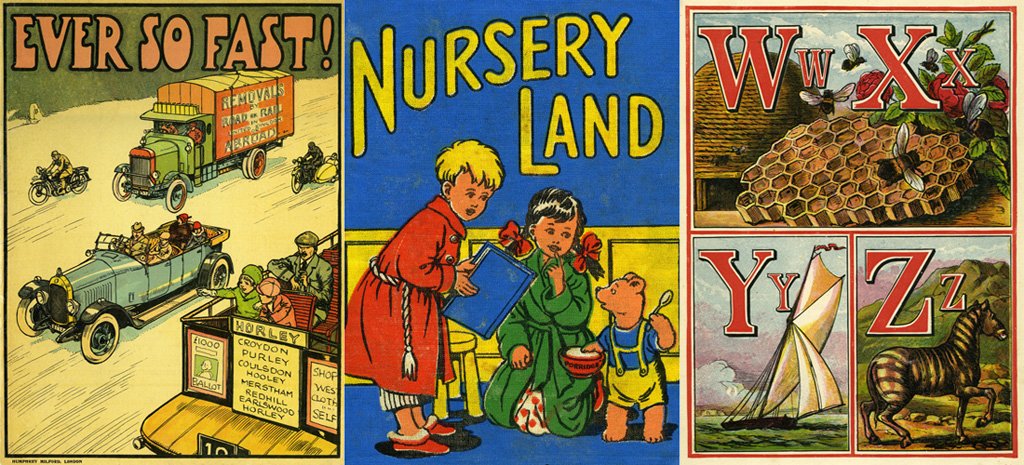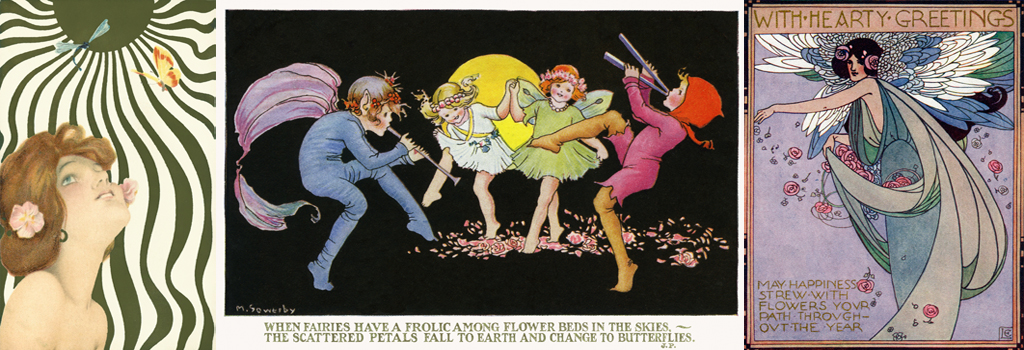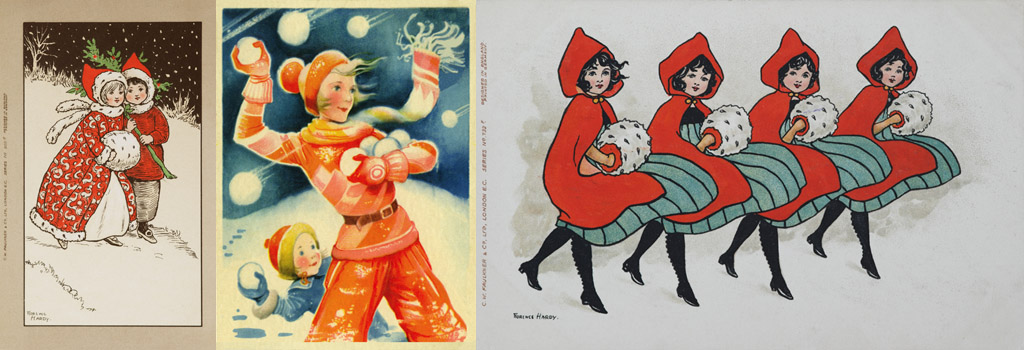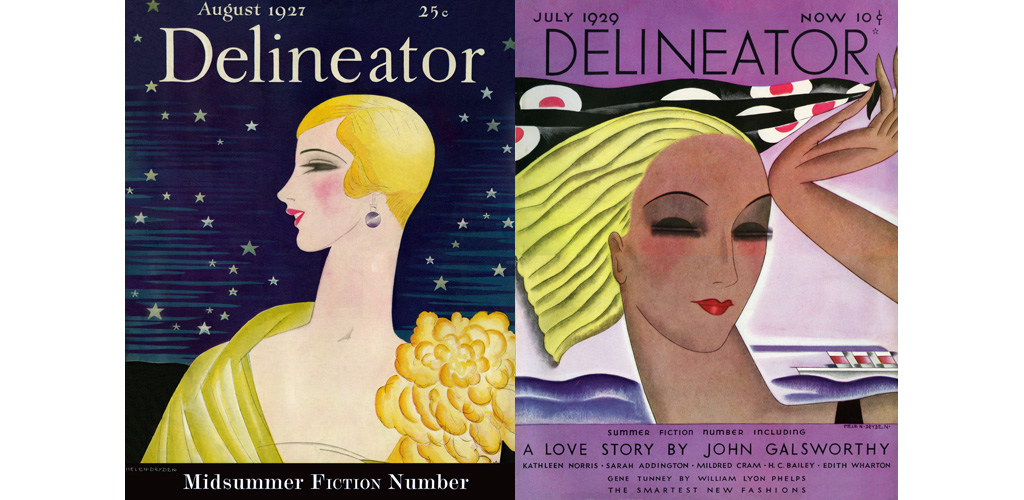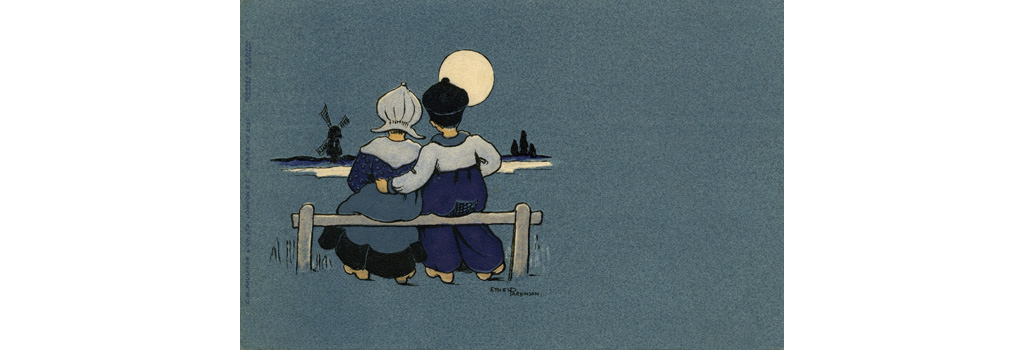The magical collection of postcards and ephemera amassed by Peter and Dawn Cope has been represented by us here at Mary Evans for almost eight years. We quizzed its owners, the authors of ‘Postcards from the Nursery’ (Cavendish Publishing, 2000) on the origins of this incredible archive. Read on to discover more:
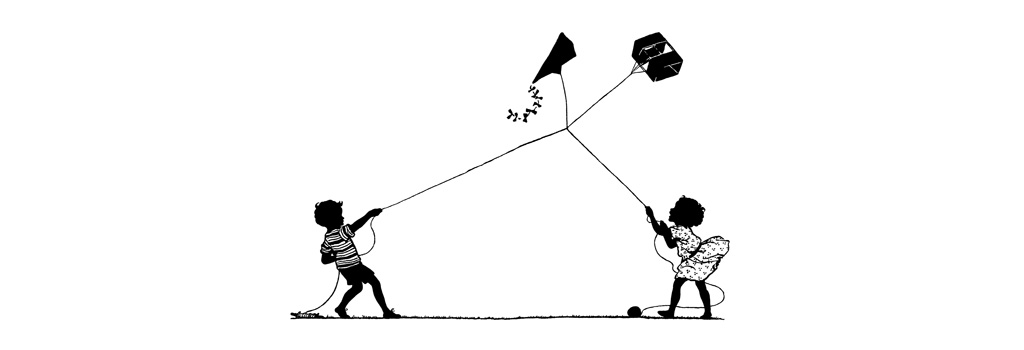
What sparked your interest in postcards and their illustrators?
Good question. It comes down to the fact that Dawn trained as an architect and I was trained as a graphic designer, so we love visual imagery. In the early seventies when we were raising our family, we were attracted to a very shabby copy of Kate Greenaway’s ‘A Apple Pie’ at the Saturday antique market held behind The Standard pub in Blackheath. From there we built up an good collection of Greenaway books which were fashionable at the time.
Then we began to attend book auctions at Sothebys, then held at Chancery Lane. Here we met plenty of book people who opened our eyes to other illustrators including Willebeek le Mair, Charles Robinson, Rackham, etc, etc. I recall that we bid for and bought for £470 a set of 10 watercolours by Millicent Sowerby, illustrated by her for publication in Humphrey Milford children’s annuals. This led us into collecting 1920s children’s books.
On a rainy holiday trudging round a market in Truro we stumbled on a postcard album brim full of postcards illustrated by Humphrey Milford artists like Lilian Govey, Eileen Hood, Susan Pearse and Millicent Sowerby. Contained in the album were 500 postcards sent to two children living in Plymouth by their parents (who were away a lot) and their grandma. This fed our appetite for more, so countless postcard fairs then ensued.
It’s a pretty extensive collection. Do you know how many postcards you have?
About 10,000.
And are you still collecting?
Yes. The collection has broadened to include various artists and publishers whose illustrative work epitomises social taste and the activities of the period 1900-1930 – the years covered by our collection.
Do you have a particular favourite illustrator?
One of our many favourites is Florence Hardy, sister of Dudley Hardy and daughter of marine painter Thomas Bush Hardy. She trained at the Sorbonne as a miniaturist. But by the time she graduated there wasn’t much demand for miniature painting. And when her father drank himself to death in 1897 leaving his new young wife (formerly the family housemaid) with a baby, Florence was obliged to seek work as a postcard and greeting card illustrator, to support the large family. I was told she worked with a magnifying glass. If you look at one of her postcards you will appreciate that it is carried out with the precision of a miniaturist.
A lot of postcard artists in this genre were women. Why do you think this is?
There is a section on the rise of women artists in our book (see pages 22-25). Briefly, towards the end of the nineteenth century more girls had the freedom to attend art school at a time when women were campaigning for greater independence. Enterprising women, mainly from the middle class, found that they could combine freelance commercial illustration without compromising their family duties. And when World War 1 came along they contributed to the war effort by creating patriotic postcards featuring children, aimed at spreading propaganda to the youngest members of society.
Did you meet any of the artists featured in ‘Postcards from the Nursery’?
We met Molly Brett, René Cloke, Kay Nixon, Susan Pearse, Joyce Plumstead, Jenifer Rickard and May Smith. We also met many of the next generation whose artist relatives were by then deceased.
Other than postcards, do you collect any other types of ephemera?
Post-Victorian greeting cards (many illustrated by our favourite postcard illustrators)
Illustrated children’s books including:
Dean’s Rag Books and Rag Sheets 1902-1940 (about 300+ rag books and 100+ rag sheets) Miniature children’s books published by Humphrey Milford (about 300 books)
Kate Greenaway (extensive collection)
Henriette Willebeek le Mair (extensive collection of books, postcards and china)**
Paintings and drawings by children’s book artists including:
Florence Mary Anderson, Maude Angell, Honor Appleton, Edith Berkeley, Edna Clarke-Hall, Muriel Dawson, Charles Folkard, Lilian Govey, Kate Greenaway, Florence Hardy, Helen Jacobs, Helen Grace Marsh Lambert, Ethel Larcombe, Joyce Mercer, Ethel Parkinson, Susan Beatrice Pearse, Rosa Petherick, Agnes Richardson, Millicent Sowerby, Fred Spurgin, Margaret Tarrant, Dorothy Wheeler.
Nursery china
Penguin Books published 1960-1980 (about 2200 books)
Books on art and design
**During the nineteen seventies and eighties I acted as design consultant to a London-based publisher,
reproducing the illustrations of Henriette Willebeek le Mair into books and on to porcelain in a more modern format. As a result we were introduced to the son of her original publisher, Augener. He sold me several signed limited edition copies of her famous books.
Do you have any plans for your collection?
Our prime concern is deciding how best to keep the collection intact after we depart. Currently we are at an advanced stage of building a Filemaker database for the postcard collection which may be extended to our greeting cards and other ephemera in due course. Ideally, we will want to sell the collection as a single entity to a university library or national institution either in the UK or abroad.
Have you ever considered an exhibition?
We have held a successful three month exhibition entitled ‘Postcards from the Nursery’ at Bethnal Green Museum in 1979, which was widely reviewed in the national press. One of our guests was Susan Pearse, artist of the Ameliaranne series of books from the twenties, thirties and forties, who was approaching 100 years of age by the time the exhibition opened.
We would love to mount another exhibition and create another book with a fresh presentation, make corrections and add new material and information gleaned over the ensuing years since ‘Postcards from the Nursery’ was published 17 years ago. Ideas and suggestions would be most welcome.
Can you explain the obsession among postcard artists with Holland?
In Edwardian Britain people began to venture abroad for their summer holidays. Holland was the popular destination of choice. The Dutch were friendly and welcoming and most of them spoke English, whereas the French, after many years battling with the British, tended to be less welcoming towards British holidaymakers.
Spain and Italy were too distant for all but the wealthy. Consequently, the Dutch responded to this surge of British visitors by creating a huge market for souvenirs for the British to take home, and postcards that they could send back to their loved ones. At this time children seldom went abroad with their parents, but remained at home with their governesses, so they would receive postcards from their parents depicting Dutch children.
Here’s a lightbox of 100 images from the Peter & Dawn Cope collection.

